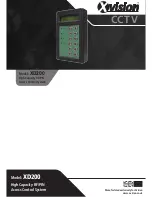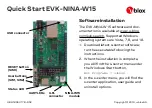
2
This book will discuss installation and wiring of the bypass
controller and bypass actuator. The bypass damper and duct
system should already be correctly sized and installed. The by-
pass actuator should be sized to match the bypass damper.
Carrier provides system software that can be used to design the
system and choose the correct dampers and actuators based on
the application.
Bypass Controller Hardware —
The bypass control-
ler consists of the following hardware:
• control module
• plastic enclosure with integrated actuator
• one no. 8 x
3
/
4
-in. self-drilling sheet metal screw
Figure 1 shows the bypass controller physical details.
Field-Supplied Hardware —
Each bypass controller
requires the following field-supplied components to complete
its installation:
• damper
• damper actuator (if high-torque actuator is required)
• transformer — 24 vac, 40 va (standard applications)
• duct temperature sensor (33ZCSENDAT) with grommet
(to secure DAT sensor to duct)
DUCT TEMPERATURE SENSOR (DAT) — The bypass
controller must be connected to a field-supplied duct tempera-
ture sensor (part number 33ZCSENDAT) to monitor the tem-
perature of the air delivered by the air source.
Mount Bypass Controller
LOCATION — The bypass controller should be located on or
near the bypass damper in a ceiling area where accessible.
When an external high-torque actuator is used, the bypass
controller is mounted on the shaft of the damper. Select a
location which will be safe from water damage and allow
sufficient access for service and wiring. For service access,
there should be at least 6 in. of clearance between the front of
the bypass controller and adjacent surfaces. Refer to Fig. 1-3.
MOUNTING — Perform the following steps to mount the
bypass controller:
1. Visually inspect the damper and determine the direc-
tion in which the damper shaft moves to open the
damper — clockwise (CW) or counterclockwise
(CCW).
If the damper rotates CCW to open, it does not require
any configuration changes.
If the damper rotates CW to open, then the damper
actuator logic must be reversed. This is done in the
software when performing system start-up and damper
calibration test. Do not attempt to change damper rota-
tion by changing wiring. This will upset the damper
position feedback potentiometer readings.
2. Rotate the damper shaft to the fully closed position.
3. Press the release button on the actuator and rotate the
clamp in the same direction that was required to close
the damper in Step 2.
4. Press the actuator release button and rotate the actuator
back one-position of graduation. Release the button
and lock the actuator in this position.
5. Mount the bypass controller to the terminal by sliding
the damper shaft through the actuator clamp assembly.
See Fig. 2 for details. Remove the controller wiring
access cover. Secure the controller by installing the
screw provided through the grommet in the anti-
rotation slot. Detach the grommet from the slot so it
can slide from side to side. Be sure the floating grom-
met is in the center of the slot. FAILURE TO
CENTER THE GROMMET MAY CAUSE THE
ACTUATOR TO STICK OR BIND.
6. Tighten the actuator clamp assembly to the damper
shaft. Secure by tightening the two 8-mm nuts.
7. If the damper has less than 90 degrees of travel
between the fully open and fully closed positions, then
a mechanical stop must be set on the actuator. The
mechanical stop prevents the damper from opening
past the maximum damper position. To set the
mechanical stop, perform the following procedure:
a.
Press the actuator release button and rotate the
damper to the fully open position.
b.
Using a No. 1 Phillips screwdriver, loosen the
appropriate stop clamp screw and move the stop
clamp so that it contacts the edge of the cam on
the actuator.
c.
Secure the stop clamp in this position by tighten-
ing the screw.
8. Verify that the damper opens and closes. Press the
actuator release button and rotate the damper. Verify
that the damper does not rotate past the fully open
position. Release the button and lock the damper in the
fully open position.
9. Replace wiring access cover.
Connect the Power Transformer —
An individual,
field-supplied, 24-vac power transformer is required for each
bypass controller. Transformers must be UL (Underwriters’
Laboratories) Class 2 rated. Standard applications require a
24 vac transformer, rated at 40 va minimum. All transformer
secondaries are required to be grounded. Use only stranded
copper conductors for all wiring to the bypass controller.
Wiring connections must be made in accordance with NEC
(National Electrical Code) and local codes. Ground one side of
the transformer secondary at the transformer location. Connect
the grounded side of the transformer to J1-2. Connect the live
side of the transformer secondary to J1-1. Connect an 18-gage,
green ground wire from terminal J1-3 to the metal chassis of
the unit.
The power supply is 24 vac ± 10% at 40 va (50/60 Hz).
For bypass controllers, the power requirement sizing allows
for the bypass actuator. The bypass damper actuator is limited
to 20 va.
NOTE: Do not run sensor or communication wiring in the
same conduit with line-voltage wiring.
Perform the following steps to connect the power
transformer:
1. Install the field-supplied transformer in an electrical
enclosure that conforms to NEC and local codes.
2. Connect 24 vac from the transformer as shown in the
applicable wiring diagram (Fig. 4). Be sure to observe
polarity when connecting the transformer power. The
grounded terminal must be connected to the transformer
ground terminal as shown.
Summary of Contents for VVT 33ZC
Page 3: ...3 Fig 2 Bypass Controller Dimensions Fig 1 Bypass Controller Details...
Page 7: ...7 Fig 7 High Torque Actuator Wiring...
Page 8: ...8 Fig 8 High Torque Actuator with Linked Dampers Wiring...
Page 9: ...9 Fig 9 Field Supplied Linked Damper Wiring...
Page 10: ...10 Fig 10 Multiple Field Supplied Linked Damper Wiring...



































